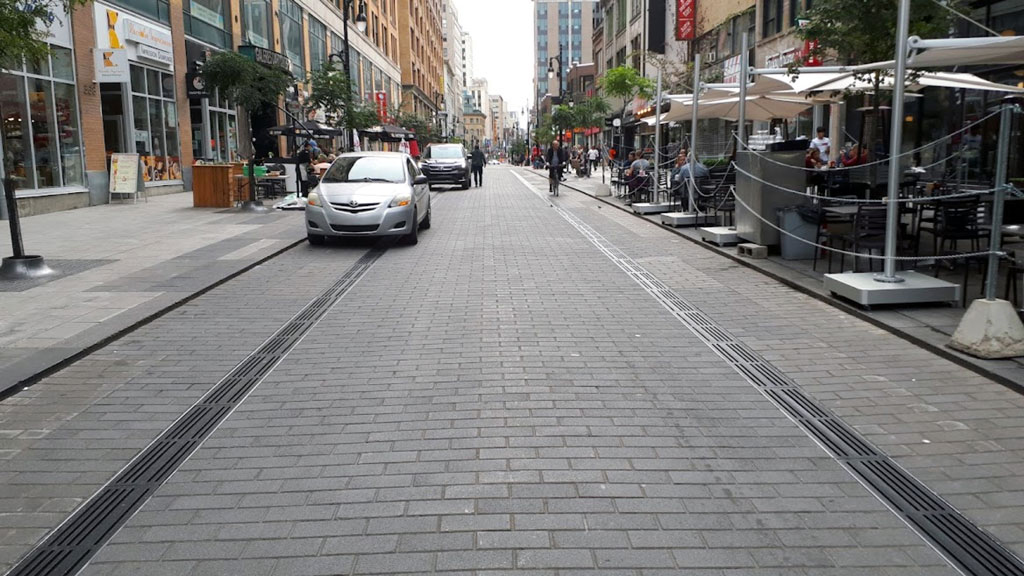Sainte Catherine, Montreal’s main downtown commercial street is undergoing a once-in-a-century transformation designed to enhance an already heavily pedestrianized artery.
In fact, pedestrians make up 70 per cent of the street’s traffic and accordingly, the reimagined plan from de Bleury Street on the east to Atwater Street on the west (2.3 kilometres), will be expanded to give those walkers wider berth at the same time as reducing motorized traffic.
The sidewalk space is being increased by 60 per cent, from 43 per cent for sidewalks and 57 per cent for street pavement to 68 per cent for sidewalks and 32 per cent pavement.
There will now only be a single lane for motorists and parking has been eliminated.
Work on the $387.5 million multi-year project began in January 2018 and no completion date has been set yet. However, the first section of work is almost complete, six blocks from de Bluery to Mansfield streets. The additional dozen blocks or 1.7 kilometres to reach Atwater will take a “few” more years with a final schedule to be issued after consultation with other area construction projects, the City of Montreal says.
Chief among the visible enhancements are the widened sidewalks on both sides and the former traditional concrete pads replaced with paving stones of different colours and textures. There is also uniquely designed street furniture like flat benches. Curb cuts are flush with the pavement making for a seamless transition for people in wheelchairs.
While traditional streetlamp design has been maintained, lights have been replaced with LED bulbs and electrical outlets are incorporated into the street furniture for street buskers and others to plug into.
“Granite is used for curbs and the watercourse has been lowered to 50 millimetres instead of the usual 150 millimetres, all in order to promote seasonal pedestrianization of this highly commercial artery,” said city spokesman Hugo Bourgoin.
But the most challenging work was underground.
The tight excavation featured a variety of infrastructure, some dating back 140 years. This included a 1,500 millimetre diameter brick circular sewer built in the 1890s at a depth of more than eight metres.
There were more than century old 600 millimetre diameter and smaller grey cast iron water pipes. There were two different water pressures, high pressure in 300-millimetre pipes for taller buildings and low pressure in secondary 150 millimetre pipes. Some underground sections had two gas lines – one 400 millimetres and the other 114 millimetres. All electrical distribution and communication conduits were also underground.
As a result, conventional excavation techniques were dismissed for hydro-excavation, “minimizing the risk of service failures often caused by traditional techniques,” Bourgoin said.
“The main challenge has therefore been to be able to replace all of this aging infrastructure while maintaining a level of service and accessibility that affects commercial and institutional operations as little as possible in this high-traffic and densely populated sector.”
The “first step” was rehabilitating the 1,500 millimetre diameter manifold sewer, still in a “relatively healthy state despite its advanced age,” Bourgoin said. This was done by inserting a resin lining hardened by air or water pressure and high temperature steam.
For water pipes, planners opted for ductile cast iron and, in some cases, larger diameter and concrete-steel pipes. Electrical and telecommunication lines are now PVC covered with a protective layer of concrete to “include everything inside a compact mass,” Bourgoin said.
For gas lines, most of them have been retrofitted with an epoxy coating for maximum life.
This underground work required special dexterity.
Sewer work, for example, was done in the middle of winter, the time when residual flows are lowest. The technique needed a complete bypass of flows, therefore requiring constant pumping to ensure maintenance of services to adjacent buildings and to avoid backups.
The work could not have been carried out at other times of the year because of greater rainfall risk, having made it impossible to divert flows.
“This technique, without mass excavation, has rehabilitated nearly 400 linear metres of pipe in just four months of work,” Bourgoin said. “A standard excavation method would have required much greater soil displacements and several additional months to complete.”
The second step was to rebuild and refurbish all the drinking water, fire protection, electricity, telecommunications and gas distribution, also located below.
To minimize the timeframe work was carried out according to a 24-hour schedule where the teams took turns without interruption. Pavement foundations were also completed.
The last stage was surface reconstruction. Besides reconfiguring the pedestrian-to-car area the street is being “greened” with 95 trees in planter pits.
The former sidewalks and pavement were torn up and replaced with a lowered granite edge and underlying concrete slab “to ensure minimum settlement and flatness of the structures in the long term,” Bourgoin said. There are also linear drainage gutters installed on both sides of the street pavement itself.
There had been speculation the new sidewalks would be heated to melt the ice and snow of Montreal’s harsh winters. But the concept was dropped because of the “insurmountable and incompatible technical issues with respect to the timelines for completion of the work,” Bourgoin said.
Several contractors have been employed for below ground and surface work.
The City of Montreal is paying for the majority of the project with reimbursement for private utility relocation.



Recent Comments
comments for this post are closed